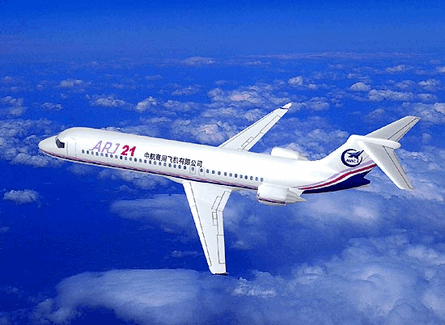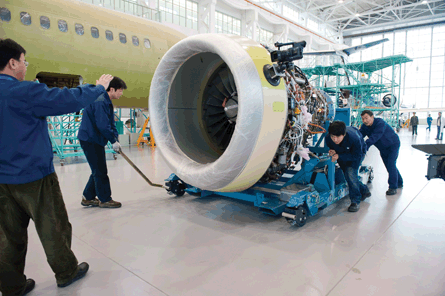China is trying to become the fifth major player in commercial aircraft manufacturing, but it is unclear whether the "China-made" product can be a commercial success.
No-one doubts that commercial aircraft can be manufactured in the country, but whether its aircraft can succeed against established players such as Airbus, Boeing, Bombardier and Embraer is another question.
The newly formed Commercial Aircraft Corporation of China (Comac) is spearheading the initiative. This Shanghai-based company is headed by two political heavyweights - chairman Zhang Qingwei and president Jin Zhuanglong.
Zhang was previously minister of China's Commission of Science Technology and Industry for National Defence and Jin was a vice-minister. Both men are credited with managing China's successful space programme, which in September 2008 put the first Chinese astronauts into space.
Zhang is higher on the political ladder than Lin Zuoming, China Aviation Industry Corporation's president, and Comac was formed in May 2008 by taking key businesses from AVIC. These were AVIC I Commercial Aircraft (ACAC), Shanghai Aircraft (SAC) and aircraft design outfit First Aircraft Institute.
 |
|---|
ACAC is responsible for China's ARJ21-700 regional jet programme. So far three ARJ21s have been built for the test programme and six test aircraft will be built, including one for fatigue testing and one for static testing. ACAC has recently transferred an ARJ21 to the national flight test centre in Xian.
ORDER CLAIM
The company claims to have orders for more than 200 ARJ21s, but some are letters of intent or memoranda of understanding. Its largest customer is Shenzhen Airlines' Kunpeng Airlines, which on 21 December 2007 - during a nationally televised roll-out of the ARJ21 - signed a firm order for 50 ARJ21s with options for 50 more. In March, Kunpeng disclosed that it will be the launch operator of the ARJ21 and is due to receive its first ARJ21 by the end of 2010.
The launch customer was to have been Shandong Airlines, which has a firm order for 10 aircraft, but it has delayed getting ARJ21s. A new timeframe for delivery has yet to be determined.
There are also doubts over Shanghai Airlines' order for five ARJ21s now that China Eastern Airlines is taking over the smaller Shanghai carrier. China Eastern has a mandate from the government to do whatever it takes to be profitable, even if it means delaying or cancelling aircraft on order.
Shenzhen Financial Leasing has a firm order for 20 and GE Commercial Aviation Services has ordered five. But Shenzhen Financial Leasing in 2000 ordered 60 Xian MA60s, although received only a handful because it was unable to find customers for the aircraft, particularly in China.
It is unclear whether Shenzhen Financial Leasing and GECAS can find customers in China for the ARJ21 because of the impediments that inhibit the growth of regional aviation in the country. Today there are about 1,300 commercial aircraft in China, but only 110 are regional aircraft, accounting for 7-8% of the total commercial fleet. In the USA and Europe regional aircraft account for 43% and 36% respectively.
Beijing has told carriers that there needs to be more air services in western China and other remote regions. Governments, particularly provincial governments in these remote areas, have been offering subsidies to those that operate on new regional routes, but the carriers appear slow to take up the offer.
An analysis by Embraer China, using publicly available information from the Civil Aviation Administration of China, shows that at the end of 2008 China had 152 commercial airports, with 47 accounting for 96% of the total passenger traffic. There are 98 airports with fewer than 10 flights a day.
Embraer's analysis also reveals that there were 470,000 flights last year with fewer than 100 passengers on board aircraft with more than 150 seats.
ACAC has attempted to promote regional aircraft to Chinese airlines but, like Bombardier and Embraer, faces an uphill battle, with one of the hurdles being that regional aircraft such as the ARJ21 have a higher cost per available seat kilometre than larger aircraft.
Airlines in China have done little to differentiate their service and have resorted to discounting air tickets. Passengers generally book with whichever airline is the cheapest, which means carriers are focused on protecting their yields by reducing operating costs as measured by cost per ASK. On regional routes it is difficult to charge a premium to make up for the higher cost per ASK.
Because passengers are used to cheap fares on trunk routes, they are unwilling to pay more to fly on regional routes. Pilot shortages also remain a problem and inhibit the growth of regional aviation. Traditionally pilots who operate regional aircraft earn less than pilots flying larger aircraft.
But because of the shortage, regional aircraft pilots are demanding the same as their counterparts who fly narrowbodies such as Airbus A320s and Boeing 737s.
Some also prefer large aircraft because they can operate on longer routes, making it easier to generate the flight hours used to calculate wages. Pilots of regional aircraft, which generally fly shorter routes, must perform more take-offs and landings to generate the same amount of flight hours.
All these factors work against regional aviation and have led to Chinese airlines ordering larger aircraft from Airbus and Boeing - China accounts for 15% of Airbus's total sales.
 |
|---|
© General ElectricGE is supplying CF34-10A engines for the ARJ21 |
But China is no longer content to just keep ordering aircraft from the two industry giants.
This explains why Comac has taken the ambitious step of starting to develop a 130- to 200-seat jet aircraft, the Comac 919. Comac aims to have the 919 enter service in 2016 and the company is working on the design and seeking suppliers for the engines, landing gear and avionics.
Some industry observers are concerned Comac may be stretching its resources too thin by pursuing two commercial aircraft programmes simultaneously.
Many involved in the ARJ21 programme are also assigned to work on the 919. There are also concerns 2016 may be too soon for the aircraft. China wants the 919 to enter the market before Airbus and Boeing have a chance to launch new narrowbodies. But another goal the government has set the nation's aerospace firms is that they be more involved in the development of aircraft systems, which will take time. AVIC Engines, for example, is bidding to supply the engines to power the 919. The firm is open to partnering Western engine makers, but wants to develop new and technologically advanced engines and own the intellectual property rights.
The tight deadline for service entry means some Western suppliers are predicting Comac will end up choosing systems in existence today that are proven and tested. So far Comac has yet to secure launch customers for the 919 and Chinese carriers are more unwilling to order Chinese aircraft simply to please the government, becoming increasingly adept at getting out of aircraft deals, as evident by Shandong Airlines' handling of its ARJ21 order.
Concerns also persist over whether Comac can properly support its products in China and overseas to the level airlines have become accustomed to. As Shanghai Airlines' chairman Zhou Chi said in 2003, Chinese aircraft makers in the past have "not had a perfect [after-sales] service system" and Shanghai Airlines hopes Chinese aircraft makers can raise their game.
He made the remarks soon after Shanghai Airlines ordered five ARJ21s and added that ACAC had "promised to build a nice after-sales support system".
ACAC is building a customer support centre in Shanghai to support Shanghai Airlines and other Chinese customers, but it may take decades for aircraft makers to develop a comprehensive international support network.
Source: Flight International
















